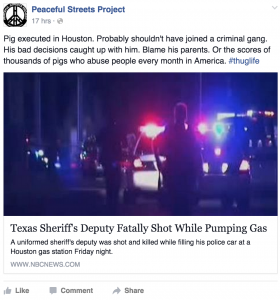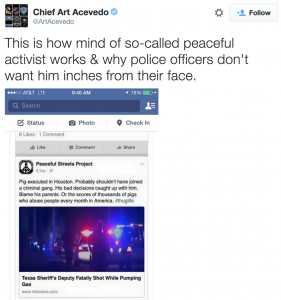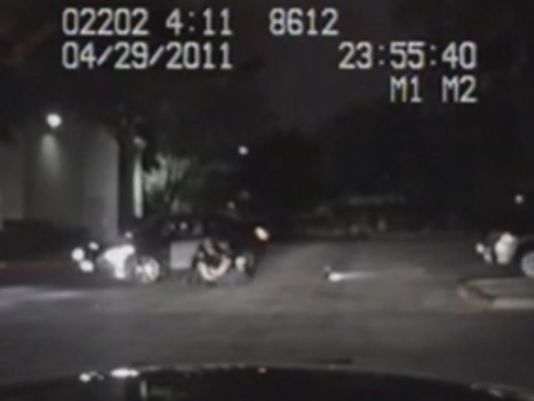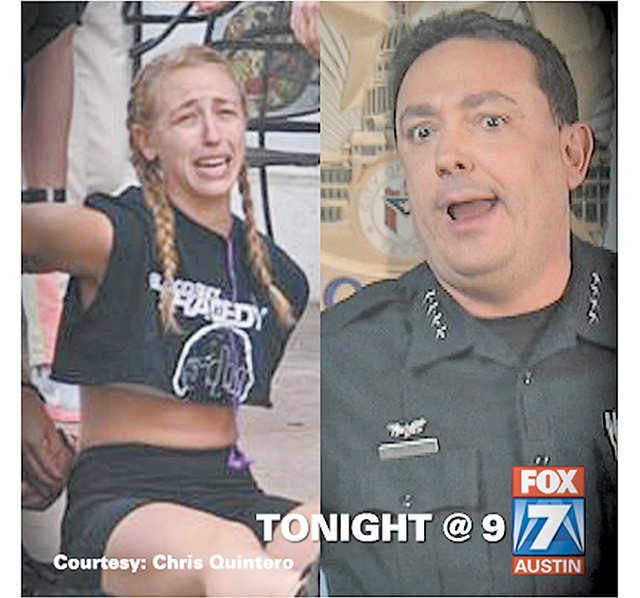Should we slander dead cops? How does the mind of a peace officer work?
It is Peaceful Streets Project’s hope that Acevedo’s reaction of disgust at the slander rhetoric of a slain officer’s character will provide him with some insight into the injustice of a practice so commonplace in the news media, police press conference rhetoric, and bigoted minded individuals, that much of mainstream white America shows a selective impairment in the identification and expression of similar disdain when the equivalent practice is applied to victims of police abuse—particularly when those victims are black men and boys. Indeed, it is our hope that Acevedo might examine his reaction to this injustice and note that others, when faced with a parallel situation, might dare to feel the same way. Indeed, it is conceivable that just like him, others may likewise conclude, “This is how the mind of so-called Peace Officers work and why some members of our community don’t want officers inches from their face.”
The irony here is that Art Acevedo and his supporters are missing the point entirely, yet driving it home precisely: yes, it is offensive, hurtful, and callous to slander a slain victim irrespective of whatever preconceived notions or judgments a complete stranger has about his or her character. The disproportionate outcry when this happens to a slain officer relative to a slain black person is precisely why the specificity that black lives matter is important. The public already understands that officer’s lives matter—that is why these comments ignite such visceral anger. This reaction is all but absent from large segments of white America when the tables are turned, however, and a black person is slain at the hands of police. Indeed, this outrage and empathy gap betrays the ardent protests that “all lives matter.”
This was posted in response to the predictable outrage that resulted from us using the same rhetoric about a slain police officer that the police, their supporters, and the media use to dehumanize a person of color each time a cop kills one of them.
The hypocrisy of the police and their supporters perpetuate violence
Last night a Harris County Sheriff’s Deputy was allegedly shot and killed execution style at a gas station. Like clockwork, while ignoring stories of Texas cops executing an unarmed man with his arms in the air and another who was a patient at a hospital, cops and cop supporters went to social media to declare the dead cop a hero while claiming that there is a “war on police.” Their response to a cop getting killed relative to a cop executing someone highlighted how much they believe cop lives matter, versus how much they believe everyone else’s lives matter.
The usual cop worship sickens those of us who have been struggling to try to get society to evolve to the point where they believe that just because you give a bully a badge, a gun, and qualified immunity, doesn’t mean that they should be celebrated for receiving tax dollars to beat, frame, rape, and murder without consequence. Therefore, we decided to post the story of the cop being killed on Facebook, with a comment that mirrored comments made each time a cop kills someone, especially a person of color.

As is common when a cop kills a young person of color, the cops and their supporters are often eager to claim that the victim was involved in criminal activity, and thus, you should then conclude that the extrajudicial killing of the victim was somehow warranted. When you point out that the police officer shouldn’t have executed the person even if they were involved in criminal activity, the cops and their supporters will quickly argue that the victim made bad decisions that put them in the unfortunate position of being executed by a cop. And particularly when the victim is black, you have the usual suspects quickly claiming that the cop murdering a young person can somehow be blamed on the bad or absent parenting the victim received.
Our Facebook post was meant to serve as a mirror for those who reflexively defend criminal cops while slandering their victims. Instead of helping people come to terms with their hypocritical view of crime and personal responsibility, all we got was a bunch of hysterical responses from the people who are so often eager to slander the dead.
Not surprising, the biggest critics were the police officers who make it standard operating procedure to attack the character, the life, and the families of the people they kill. One of the biggest hypocrite cops in America is Austin Police Chief Hubert “Art” Acevedo who quickly shared a screenshot of our post with the comment, “This is how mind of so-called peaceful activist works & why police officers don’t want him inches from their face.” We couldn’t have asked for a better example of a cowardly, criminal, terrorist cop to respond to our posting that that of Acevedo.
 First, Acevedo is either stupid enough to not catch onto the fact that we were using the tactics of cops across America to make a point, or dishonest enough that he pretended to not notice it. Either way, that alone gives some indication to the degree to which he is unfit for his job. Second, the mind of a peaceful activist is obviously beyond the comprehension of a tax parasite violent terrorist cop. We endeavor to call out violence and to encourage people to find the courage within themselves to stand up to it. Acevedo and his fellow cops simply endeavor to dispense violence on the people and to promote the cowardice of the profession of policing (e.g., shooting every time they “fear for their lives”). Thirdly, claiming that his police officers don’t want [Peaceful Streets Project co-founder Antonio Buehler] “inches from their face [sic]” puts an exclamation point on how cowardly and corrupt Acevedo is.
First, Acevedo is either stupid enough to not catch onto the fact that we were using the tactics of cops across America to make a point, or dishonest enough that he pretended to not notice it. Either way, that alone gives some indication to the degree to which he is unfit for his job. Second, the mind of a peaceful activist is obviously beyond the comprehension of a tax parasite violent terrorist cop. We endeavor to call out violence and to encourage people to find the courage within themselves to stand up to it. Acevedo and his fellow cops simply endeavor to dispense violence on the people and to promote the cowardice of the profession of policing (e.g., shooting every time they “fear for their lives”). Thirdly, claiming that his police officers don’t want [Peaceful Streets Project co-founder Antonio Buehler] “inches from their face [sic]” puts an exclamation point on how cowardly and corrupt Acevedo is.
The reason Acevedo references cameras a certain distance from one’s face stems from the illegal arrest of Antonio Buehler and Mike Bluehair Smith (or Film the Police Portland) by Austin Police on August 2nd, 2015. In the lie-filled affidavit written up by Austin Police Officer Aljoe Garibay, it is claimed that Buehler on multiple occasions held a camera within inches of various officers’ faces. That claim was the foundation for their ultimate claim that he was interfering with the public duties of the officers, who just happened to be doing nothing but standing around watching people film them.
The problem with Garibay and Acevedo’s claims are that they were definitively debunked by multiple videos of the arrest. In the videos, it is patently obvious that the only reason a camera was ever in any cop’s face was because the cops kept moving toward Buehler and placing their face in front of his camera. In not one sequence of shots did Buehler ever move his camera and body toward the face of a cop.
The fact that Acevedo would so blatantly lie about someone who was trying to hold his criminal cops accountable, while he has engaged in coverups of his cops illegally arresting cop watchers, highlights that Acevedo and the thin blue line is unconcerned about crime when it emanates from within the fraternity of law enforcement, but that they are all too eager to slander and attempt to dehumanize the victims of police abuse, corruption, and violence.
And that is why at the end of our Facebook post, we pointed out that perhaps the reason that every once in a blue moon someone decides to mimic the violent tactics of the police against the police may be because tens of thousands of people are victimized by police each month. Cops and their supporters love to dismiss the executions of young black men by using the twitter tag #thuglife. So we ended our post with the same. Sadly, the cops and their supporters can’t grasp the meaning of the term.
Austin Police Department’s Civil Rights Violation Costs $1 Million
By: Jermaine Hopkins & Millie Thompson

Carlos Chacon sued the City of Austin and Austin Police Department Officers Eric Copeland and Russell Rose for their use of excessive force against him. His attorney, Broadus Spivey, filed the case in Federal Court, pursuant to 42 U.S. Code § 1983 – Civil action for deprivation of rights. On Thursday evening, March 5, 2015, a jury of 12 decided the case in Chacon’s favor. Chacon was awarded $1,000,000.00 in damages. We discuss the case, the legal process, important details of the trial, and how APD’s brass inconsistently treats dishonesty by police officers.
Facts of the Case:
Chacon sued based on damages sustained at the hands of APD Officers Rose and Copeland. Chacon called 9-1-1 as a victim of a crime, informing the 9-1-1 operator that he paid for a massage but the woman offered sex, and when Chacon went to leave, a man began kicking the motel room door, yelling at him. After he made the first 9-1-1 call, the same man threatened to kill him and reached into his shorts as if grabbing a gun. Chacon entered his silver BMW, began driving around, and again called 9-1-1 to report the threat.
En route to the motel, the 9-1-1 dispatcher twice explained to the responding APD officers that the suspect was a ‘black male’ in a white shirt, black hat and black shorts, with a gun, and that the complainant (victim) – Chacon – was driving his silver BMW. There was no record of any other 9-1-1 calls being placed regarding this incident, other than Chacon’s two.
When the officers arrived at the motel, Officer Rose inexplicably asked an African American male matching the description of the suspect if he had called about a gun. The male immediately replied in the negative, but instead said that there was a drunk guy driving around in a silver BMW. The African American male claimed that he himself had called 9-1-1, about the drunk guy.
Chacon approached, driving his vehicle, and Officer Rose immediately drew his gun and pointed it at Chacon – the victim who had called 9-1-1. Rose didn’t identify himself as a police officer. Rose ordered Chacon to show his hands, and Chacon responded: “I don’t have a gun, he’s the one.” Officer Copeland joined Rose and then drew his gun, pointing it at Chacon. When the officers yanked Chacon from the vehicle, Chacon tried to again calmly explain that he was not the one with the gun. Rose and Copeland wrestled Chacon to the ground, giving conflicting commands, and Copeland punched him in the face twice, causing a cut above Chacon’s eye. Then, Officer Rose tased Chacon. Chacon was arrested for resisting arrest. That resisting arrest case was dismissed.
You can find the dash-cam video/audio here.
Procedural History of the Federal Civil Rights Case:
Officers Rose and Copeland tried to have the case tossed on qualified immunity grounds, arguing that they were immune from suit because they were acting properly in their official capacity as police officers. On May 21, 2013, Federal District Judge Sparks issued a ruling denying the City of Austin’s Motion for Summary Judgment in Chacon’s lawsuit. In his ruling, Judge Sparks pointed out Rose’s “obvious post-hoc explanation for his behavior, and is completely discredited by his actions as captured by his own dashboard camera… The Court therefore disregards Officer Rose’s explanation, and instead defers to the video evidence, which clearly contradicts his affidavit’s claim.” Rose, a white officer, to-date has not been terminated or disciplined for dishonesty.
On March 2 and 3, 2015, Chief Acevedo was provided with information regarding the dishonest and rehearsed testimony given under oath by Rose, Copeland, and Smith. To date, Chief Acevedo has not responded to that information.
Both the district court and Fifth Circuit Court of Appeals refused to dismiss Chacon’s case against the two officers. In the officers’ interlocutory appeal (meaning that they didn’t have to wait for a jury to hear the case before they could appeal on the issue of immunity from suit), the Fifth Circuit had to decide whether there was a factual dispute regarding whether the police violated an actual constitutional right, considering 1) the severity of the crime at issue, 2) whether Chacon posed an immediate threat to the safety of the officers or others, and 3) whether Chacon actively resisted arrested or attempted to flee.
The Fifth Circuit reasoned that the video of the assault did not entirely confirm the officers’ version of events, nor did it entirely refute Chacon’s version. Notably, Chacon was given contradictory commands during the assault, including to “not move,” but “get on the ground,” but “stop moving,” but “turn over.”
The Fifth Circuit concluded that there was a fact issue that a jury must decide: “Even if some action by Chacon demonstrated resistance, the fact question found by the district court remains: whether, even considering his possible resistance, shoving Chacon to the ground while he attempted to explain himself, punching him in the head while he was on the ground, or shooting him with a Taser, constituted excessive force. Police are entitled only to measured and ascending responses to the actions of a suspect, calibrated to physical and verbal resistance shown by that suspect.”
And, so, the case against Officers Rose and Copeland proceeded to the jury.
The Trial – The Jury Had to Decide Who Was Credible:
The dash-cam video was played numerous times and dissected in the courtroom. Despite the efforts of the Assistant City Attorney to discredit him, Carlos Chacon came across as a very credible witness as he described the events taking place on that traumatic night and how those experiences have adversely impacted his life. He informed the jury that he reached out to Chief Acevedo, who did not respond to his letter. He also denied consuming any alcoholic beverages that painful evening.
Rose testified that he did not hear the information provided by the dispatcher, while the dash-cam audio clearly captured the dispatcher twice describing the suspect and victim.
Copeland testified that he detected the strong odor of an alcoholic beverage emitting from Chacon, but Chacon was never charged with Public Intoxication or Driving While Intoxicated. Additionally, Chacon’s hospital records failed to confirm Copeland’s alcohol allegation, which was also refuted by Rose’s prior testimony. Nevertheless, according to his police report, Rose claimed to suspect that Chacon was under the influence of alcohol/drugs.
Rose and Copeland’s supervisor, Sgt. Robert Smith, also testified that he detected a strong odor of an alcoholic beverage emitting from Chacon, but he was never as close to Chacon as Rose, nor was he able to explain why the medical personnel at the emergency room did not report any signs of intoxication in Chacon’s medical records. However, Smith stated that it did not mean anything to him. Chacon’s attorney Broadus Spivey asked Smith about why Chacon was not charged with Driving While Intoxicated or Public Intoxication; Smith responded, “I think we don’t just arbitrarily stack charges on someone.” But, when later asked why he recommended that Rose or Copeland conduct sobriety tests on Chacon, who was already under arrest for the alleged Resisting Search offense, Smith replied “to see if there were any other charges we could put on him.” (Authors’ Note: Rest assured, despite what the officers claimed, APD never lets a DWI go!)
Leading up to trial, Judge Sparks questioned Sgt. Smith about why the Austin Police Department failed to investigate the circumstances that prompted Mr. Chacon to call the police. However, contrary to his self-described job duties, Smith could only say “I don’t know.” As Copeland and Rose’s supervisor, it was his job to know.
Chacon’s legal team called expert witness Dr. George Kirkham, a criminologist out of Florida. Despite Dr. Kirkham’s extensive experience that far exceeded that of Rose and Copeland’s expert witness, William Terryl, the Assistant City Attorney objected to Dr. Kirkham being allowed to testify. Judge Sparks quickly overruled the objection and decisively affirmed “he’s an expert.”
Dr. Kirkham testified, based upon his expert opinion, that the actions of Rose and Copeland were contrary to standard police practices and procedures, and that their force used was objectively unreasonable.
Had the jury believed the officers’ version of events, they would have held in the officers’ favor and Chacon would have lost the lawsuit. Instead, they found one million reasons to hold in favor of Carlos Chacon.
The jury found Russell Rose liable for $1,000,000.00, not Eric Copeland. Rose was the officer who immediately pulled his gun on Chacon, and tased him. Copeland punched Chacon in the face twice. Copeland made the news one year after the Chacon assault when he shot and killed a man.
Chief Art Acevedo’s Inconsistent Handling of Dishonesty Among his “Troops:”
On October 28, 2013, Officer Blayne Williams, an African American APD officer who had in the past filed a charge of discrimination against Chief Acevedo, was terminated based solely upon Chief Acevedo’s subjective opinion that Williams was dishonest. Chief Acevedo failed to indicate in Williams’ disciplinary memo exactly how Williams was dishonest. Even an Internal Affairs investigator testified at Williams’s arbitration that he did not know what specific statements Chief Acevedo believed were dishonest. Officer Blayne Williams fought against his termination, and an arbitrator determined that Williams was not dishonest and that he should not have been terminated.
One particular APD Officer Gallenkamp has developed a reputation for dishonesty amongst the Travis County Criminal Defense Bar. Ask your friendly criminal defense attorney about the reasons. Nevertheless, Copeland and Rose are still in uniform, having never been disciplined.
Media Presence Lacking at Chacon’s Trial:
The press did not cover Carlos Chacon’s trial, and brief news reports about the trial were only released after the jury awarded $1,000,00.00 in damages. Typically, when a case involves a matter of public concern, especially on a hot-button issue like police abuse, the press shows up during the trial testimony. Often, one will see photographers outside the courthouse, waiting to click shots of the parties. Not so in Carlos Chacon’s trial.
Austin Police Department’s Police Chief Art Acevedo is well known in Austin for his mastery of the media. In 2010, he made it clear that he wanted to stay in Austin in order to finish projects he started and “he want[ed] to finish working with the media.”
Acevedo has developed such a rapport with the media that news stations would rather fire their own than to upset him. Reporter Philip Perea committed suicide in January of this year after he was fired for posting an unflattering picture of Art Acevedo on facebook. Acevedo had responded to the assault of a jogging jaywalker by saying that “In other cities there’s cops who are actually committing sexual assaults on duty, so I thank God that this is what passes for controversy in Austin, Texas.” The picture Perea posted on facebook made Acevedo look like a buffoon. When Acevedo took issue, Perea was fired. Acevedo’s quote turned into a meme with the phrase “at least we didn’t rape you.”
APD lost more credibility when two of Acevedo’s officers joked about rape, captured by their dash-cam equipment: “Go ahead. Call the cops. They can’t unrape you.’
Acevedo lost still more credibility when he suggested that young women should not defend themselves with firearms, but should go ahead, be raped, get counseling, and get over it.
Acevedo does more than exercise some control over how the media reports on him, he has outright banned people from his twitter and facebook. These social media accounts are considered public fora, and yet, Acevedo handles them as if they were his private accounts. We’ll report more about Acevedo’s handling of social media in a subsequent blog.
Congratulations to Chacon:
In the meantime, hats-off to Carlos Chacon for being fearless and going after APD. It is frightening taking on an entity with that much power and weaponry. Hats-off to Chacon’s legal team including Broadus Spivey for fighting the good fight and winning.
City of Austin Mayor Steve Adler, are you paying attention to how much APD is costing Austin? Austin City Counsel, are you? While this assault may not have happened on y’all’s watch, you’re on-watch now. Will you protect your citizens?
Jermaine Hopkins is an Iraqi War veteran, and 14-year police officer, whose own tribulations with APD are detailed here.
Millie Thompson is a criminal defense attorney, whose office is located in Austin, Texas.
Reprinted with permission from MILLIE L. THOMPSON, ATTORNEY.


